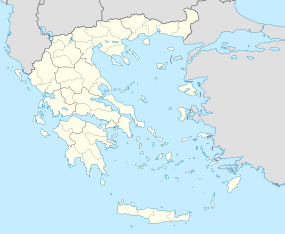Acanthus (Greece)
| Ἄκανθος (Ancient Greek) | |

Remains of an ancient house excavated in Akanthos
|
|
| Location | Ierissos, Central Macedonia, Greece |
|---|---|
| Coordinates | 40°23′54″N 23°52′42″E / 40.39833°N 23.87833°ECoordinates: 40°23′54″N 23°52′42″E / 40.39833°N 23.87833°E |
| Type | Settlement |
| History | |
| Founded | 7th century BCE |
| Abandoned | 1932 |
| Site notes | |
| Condition | Ruined |
| Ownership | Public |
| Management | 16th Ephorate of Prehistoric and Classical Antiquities |
| Public access | Yes |
| Website | Hellenic Ministry of Culture and Tourism |
Akanthos (Ancient Greek: Ἄκανθος; Latin: Acanthus) was an ancient Greek city on the Athos peninsula. It was located near the modern town of Ierissos on the north-east side of Akti, on the most eastern peninsula of Chalcidice. Strabo and Ptolemy erroneously place Acanthus on the Singitic Gulf, but there can be no doubt that the town was on the Strymonian Gulf, as is stated by Herodotus and other authorities: the error may have perhaps arisen from the territory of Acanthus having stretched as far as the Singitic Gulf. The name of the ancient city (derived from the acanthus bush) is due to the thorny nature of the area or to the thorny nature of the town's foundation.
It was founded by 7th century BC (the archaeology suggests 655 BC) by colonists from Andros, according to Thucydides.Plutarch, on the other hand, referred to it as a mixed colony of Andrians and local Chalcidians, which was founded on the "Coast of Drakontos", in place of a preexisting civilization. He writes that settlers from Andros and Chalcis arrived on the shore at the same time. The natives of Acanthus, seeing the crowd of settlers, became frightened and left the city. The settlers sent an explorer each to see what had happened and, as they approached the city and realized it was empty, ran to be the first to take over the land for their fellow countrymen. The Chalcidian was the fastest but the Andrian, seeing he was losing, stopped and threw his spear on the wall's gate, before his opponent arrived. A court case followed, which was won by the Andrians, because as they protested, they had just about taken over the city first.
Its growth during the Archaic period is reflected by the wide circulation of its currency, first minted around 530 BCE with the distinctive emblem of a lion killing a bull – perhaps linked to Herodotus’s account (vii. 125) that on the march of Xerxes from Acanthus to Therma, lions seized the camels which carried the provisions - at least 92 different types of coins have been found. Its economic resources emanated from the mining and wood from the nearby forests, but also through agricultural and vegetable goods that were transported through the sizable harbor.
...
Wikipedia

